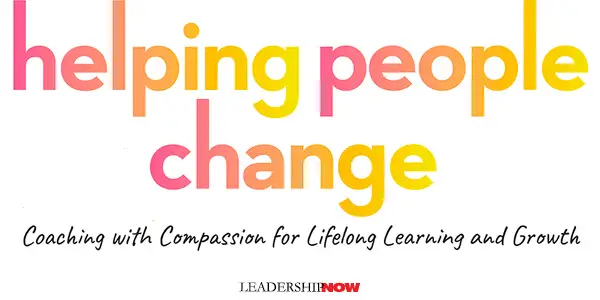 |
 |
01.13.20

Helping People Change
MOST OF US want to help people. And typically, we go about it by trying to correct a problem. We focus on what we think they should be doing. Makes sense. To us. But it frequently does not create sustainable change in the other person. Richard Boyatzis, Melvin L. Smith, and Ellen Van Oosten suggest a different approach in Helping People Change. Instead of coaching people for compliance, we should be coaching with compassion. The conventional view of coaching is that it is an activity where, “based on your experience, expertise, or authority, you advise individuals on what they should do and how they should do it. While there may be time and place for it, this type of coaching for compliance is unlikely to lead to sustained behavioral change.” When people change out of obligation, they often lack the inner motivation they need to sustain that change. For people to changes in ways that stick, that change has to connect with their passion and core values. To do that, you need to coach with compassion. Coaching with compassion is how we help a person frame the situation or opportunity in the context of who she wants to be as a person and what she would like to achieve in her ideal future. Such broad framing helps the person draw on the inner resources most likely to enable her to learn, change, or grow in the meaningful and sustained ways as she works through that situation, whatever it may be. The PEA Versus the NEA Coaching for compliance leads to a defensive response in the person being coached. They shut down and rather than learning or changing, they enter survival mode or what they term the zone of the negative emotional attractor (NEA). This is in contrast to coaching with compassion which elicits positive emotions as it focuses on a vision of a desired future state and strengths rather than weaknesses. This zone is called the positive emotional attractor (PEA). In this state, the person is relaxed and open, and new neural pathways form in the brain “paving the way for new learning, and sustained behavioral change to occur.” For sustained learning to occur, it is important that coaches manage the emotional flow of the coaching process. This means being able to both read and influence the emotions the person is experiencing. Getting people into a PEA state begins by asking the right questions. Questions that “discover their views of the word, their situation, and how they feel.” “Our mistake is in thinking—often assuming—that we can see what the other person should do to lead to a better life, be more productive, or learn more.” When we focus on the wrong things as a coach, we essentially block change. (Chapter 4 is the game-changer in this regard.) Three Cornerstones of Coaching Building a good relationship with the person you are coaching requires the right mindset. “First, believe that individual change is a process, not an event.” Change doesn’t happen overnight. We need to make room for mistakes, feedback, and more practice. “Second, consider your approach to coaching as a chance to mine for gold, not dig for dirt.” We need to connect with people’s strengths and their desired outcomes. At one time, Andrew Carnegie had 43 millionaires working for him. Carnegie was asked, "How did you develop these men to become so valuable to you that you have paid them this much money?" Carnegie replied that people are developed the same way gold is mined. When gold is mined, several tons of dirt must be moved to get an ounce of gold, but one doesn't go into the mine looking for dirt—one goes in looking for the gold. “Third, consider that the agenda for the conversation should come from the person being coached.” While the coach manages the process, “the fundamental reason for the process is to help the other person—not the coach to share his advice or experience.” It means listening more. This quote from gestalt psychotherapist Robert Lee is worth repeating every time we begin to work with others: “Our assumptions and stereotypes create filters for how we hear people. We don’t hear others from the place of who they are. We hear them through the filter of who we think they are.” When we coach for problem identification and problem-solving—as seems to make the most sense—we risk having the process becoming bogged down in negative emotions. “A problem-focused approach may seem efficient, but it ignores the fact that thinking about and arousing feelings about problems activates the NEA, which in turn can close a person’s imagination to new ideas and possibilities. Recognizing that a problem exists is quite different from spending a lot of time thinking and talking about it.” This book is invaluable not only for coaches but for leaders of all kinds—managers, parents, health care professionals pastors, and anyone who works with to guide others through life changes. The primary theme stressed throughout this book “is using personal vision to evoke positive emotions—essentially, to begin with the end in mind, thereby setting up the connections in the brain and emotions that will help us pave the road to the desired end.” 
Posted by Michael McKinney at 07:44 AM
|
BUILD YOUR KNOWLEDGE
 

How to Do Your Start-Up Right STRAIGHT TALK FOR START-UPS 
Grow Your Leadership Skills NEW AND UPCOMING LEADERSHIP BOOKS 
Leadership Minute BITE-SIZE CONCEPTS YOU CAN CHEW ON 
Classic Leadership Books BOOKS TO READ BEFORE YOU LEAD |